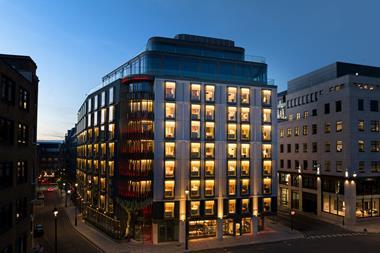Buildings are long-lived and have long lead-in times, meaning that the way we think about them now is not necessarily how our forebears will have designed them, writes Josip Kardun, chief investment officer at Mark and head of Doma.

Climate change was not the major issue it is now when many of the buildings that define our cities were built. This means that we have a lot of aged, inefficient buildings that require upgrading so that the built environment can play its part in reducing emissions.
This is especially true of housing, which is responsible across Europe for around 25% of all emissions, and 30-35% of primary energy use.
The renewal of buildings - as opposed to their demolition and reconstruction - minimises the embodied carbon and energy that are associated with construction products. There is growing recognition of the importance of embodied carbon across Europe. France, where we recently repositioned a historic luxury hotel into a high-end retail and F&B destination, is taking the important step of embodying life-cycle assessment in national building regulations.
Despite enhanced national building standards and energy certificates to educate occupiers of the energy efficiency of properties, the pace of improvement is not fast enough to meet Net Zero by 2050 and interim targets to 2030.
In 2019, an independent study by the German Environment Agency (UBA) highlighted that improvement rates in energy performance across the stock had started to level out, and further interventions and incentives were needed. Germany has the largest housing stock in Europe at around 40 million homes, presenting a retrofitting challenge of serious scale.
In the Netherlands, standards for new homes mean that they will generate as much energy as they use, but there is also a negotiated agreement with the real estate and construction sectors to improve 300,000 rental houses per year to make them more energy efficient.
Greening the existing housing stock across Europe is a way that investors in real estate can do well by doing good, creating real positive impact as well as generating returns. Practically speaking, this means finding ways to debug and scale-up retrofit of existing buildings.
Our rental housing platform Doma is focused on acquiring and managing smaller apartment blocks that are typically dated in their design and build. We invest in upgrading them to modern sustainability standards and improving energy efficiency.
Our ESG policy is based on Gresb, the UNPRI, the UN Sustainable Development Goals, and ISO 14001 environmental standards, while our ESG Committee members sit on and participate in the Doma Investment Committee. This ensures sustainability issues are addressed during the decision-making process and indirectly throughout the asset hold period.
Like our urban logistics platform Crossbay, Doma is committed to global ESG benchmark participation and Gresb reporting. Our target is to achieve at least a 3-Star Gresb rating for the portfolio and reduce embodied GHG emissions.
The advent of the green taxonomy across Europe and EU disclosure rules for companies’ alignment with the Taskforce on Climate Related Financial Disclosures (TCFD) will require companies to report on their mitigation of climate change risks and any contributions to climate mitigation opportunities. Companies investing in inefficient stock will have to explain their decisions and approach to risk.
There are limitations to what can be done from a planning and construction perspective, yet as is often argued, the most sustainable building is one that already exists. To demolish them would be a huge waste of embodied carbon.
New ground-up developments will always be needed, and many projects coming forward have put minimising their environmental impact at the heart of their designs and operations. All new developments in Doma, while not a target acquisition focus, will be developed to a minimum BREAAM rating of “Excellent”.
However, undoubtedly the greater priority is greening our existing housing stock. If governments are serious about meeting their net zero targets, they should be looking to harness the growing pool of capital wanting to enter residential real estate and access ESG-friendly projects.









